Eritrea
| State of Eritrea
ሃገረ ኤርትራ
Hagere Ertra دولة إرتريا Dawlat Iritrīya |
||||||
|---|---|---|---|---|---|---|
|
||||||
| Anthem: Ertra, Ertra, Ertra |
||||||
.svg.png) |
||||||
| Capital (and largest city) |
Asmara |
|||||
| Official language(s) | Tigrinya1, Arabic1, English1 | |||||
| Other languages | Tigre, Saho, Bilen, Afar, Kunama, Nara, Hedareb,[1][2]. | |||||
| Ethnic groups | 50% Tigrinya, 40%Tigre, 4% Afar, 3% Saho, 3% Kunama [3] | |||||
| Demonym | Eritrean | |||||
| Government | provisional government | |||||
| - | President of State | Isaias Afewerki | ||||
| Independence | ||||||
| - | From Italy | November 1941 | ||||
| - | From United Kingdom under UN Mandate | 1951 | ||||
| - | from Ethiopia de facto | 24 May 1991 | ||||
| - | From Ethiopia de jure | 24 May 1993 | ||||
| Area | ||||||
| - | Total | 117,600 km2 (100th) 45,405 sq mi |
||||
| - | Water (%) | negligible | ||||
| Population | ||||||
| - | 2009 estimate | 5,673,520[4] (118th) | ||||
| - | 2008 census | 5,291,370 | ||||
| - | Density | 43.1/km2 (165th) 111.7/sq mi |
||||
| GDP (PPP) | 2010 estimate | |||||
| - | Total | $3.598 billion[5] | ||||
| - | Per capita | $676[5] | ||||
| GDP (nominal) | 2010 estimate | |||||
| - | Total | $2.254 billion[5] | ||||
| - | Per capita | $424[5] | ||||
| HDI (2007) | ||||||
| Currency | Nakfa (ERN) |
|||||
| Time zone | EAT (UTC+3) | |||||
| - | Summer (DST) | not observed (UTC+3) | ||||
| Drives on the | right | |||||
| Internet TLD | .er | |||||
| Calling code | 291 | |||||
| 1 | [1],[2]. | |||||
Eritrea (pronounced /ˌɛrɨˈtreɪ.ə/ or /ˌɛrɨˈtriːə/;[6] Ge'ez: ኤርትራ ʾErtrā, Arabic: إرتريا Iritrīyā), officially the State of Eritrea, is a country in the North East of Africa. The capital is Asmara. It is bordered by Sudan in the west, Ethiopia in the south, and Djibouti in the southeast. The east and northeast of the country have an extensive coastline on the Red Sea, directly across from Saudi Arabia and Yemen. The Dahlak Archipelago and several of the Hanish Islands are part of Eritrea. Its size is just under 118,000 km2 (45,560 sq mi) with an estimated population of 5 million.
Contents |
Description and history
The history of Eritrea is tied to its strategic position on the southern, African side of the Red Sea; with a coastline that extends more than 1,000 km, many scientists believe that it is from this area that anatomically modern humans first expanded out of Africa.[7] From across the seas came various invaders (and colonizers) such as the South Arabians hailing from the present-day Yemen area, the Ottoman Turks, the Portuguese from Goa (India), the Egyptians, the British and, in the 19th century, the Italians. Over the centuries, invaders also came from the neighboring countries of Africa to the south (Ethiopia) and to the west (Sudan). However, present-day Eritrea was largely affected by the Italian invaders of the 19th century.
In the period following the opening of the Suez canal in 1869, when European powers scrambled for territory in Africa and tried to establish coaling stations for their ships, Italy invaded and occupied Eritrea. On January 1, 1890, Eritrea officially became a colony of Italy. In 1936, it became a province of Italian East Africa (Africa Orientale Italiana), along with Ethiopia and Italian Somaliland. The Commonwealth armed forces expelled those of Italy in 1941[8] and took over the administration of the country which had been set up by the Italians. The British continued to administer the territory under a UN Mandate until 1951 when Eritrea was federated with Ethiopia as per UN resolution 390(A) under the prompting of the United States adopted in December 1950; the resolution was adopted after a referendum to consult the people of Eritrea.
The strategic importance of Eritrea, due to its Red Sea coastline and mineral resources, was the main cause for the federation with Ethiopia, which in turn led to Eritrea's annexation as Ethiopia's 14th province in 1962. This was the culmination of a gradual process of takeover by the Ethiopian authorities, a process which included a 1959 edict establishing the compulsory teaching of Amharic, the main language of Ethiopia, in all Eritrean schools. The lack of regard for the Eritrean population led to the formation of an independence movement in the early 1960s, which erupted into a 30-year war against successive Ethiopian governments that ended in 1991. Following a UN-supervised referendum in Eritrea (dubbed UNOVER) in which the Eritrean people overwhelmingly voted for independence, Eritrea declared its independence and gained international recognition in 1993.[9]
English is used in the government's international communication and is the language of instruction in all formal education beyond the fifth grade.[10]
Eritrea is a single-party state. Though its constitution, adopted in 1997, stipulates that the state is a presidential republic with a unicameral parliamentary democracy, it has yet to be implemented.
Politics and government
Eritrea is an authoritarian state, run by the People's Front for Democracy and Justice (PFDJ).[11] Other political groups are not allowed to organise, although the non-implemented Constitution of 1997 provides for the existence of multi-party politics. The National Assembly has 150 seats, of which 75 are occupied by the PFDJ.
Independent local sources of political information on Eritrean domestic politics are scarce; in September 2001 the government closed down all of the nation's privately owned print media, and outspoken critics of the government have been arrested and held without trial, according to various international observers, including Human Rights Watch and Amnesty International.The reason for these arrests are obvious because in the struggle there were two parties (Islamic republic ELF and republic of Eritrea EPLF). In 2004 the U.S. State Department declared Eritrea a Country of Particular Concern (CPC) for its record of religious persecution.[12]
National elections
Eritrean National elections were set for 1995 and then postponed until 2001; it was then decided that because 20% of Eritrea's land was under occupation, elections would be postponed until the resolution of the conflict with Ethiopia. However, local elections have continued in Eritrea. The most recent round of local government elections were held in May 2004. On further elections, the President's Chief of Staff, Yemane Gebremeskel said,[13]
| “ | The electoral commission is handling these elections this time round so that may be the new element in this process. The national assembly has also mandated the electoral commission to set the date for national elections, so whenever the electoral commission sets the date there will be national elections. It's not dependent on regional elections. | ” |
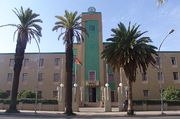
Regions and districts

Eritrea is divided into six regions (zobas) and subdivided into districts ("sub-zobas"). The geographical extent of the regions is based on their respective hydrological properties. This a dual intent on the part of the Eritrean government: to provide each administration with sufficient control over its agricultural capacity, and to eliminate historical intra-regional conflicts.
The regions, followed by the sub-region, are:
| No. | Region (ዞባ) | Sub-region (ንኡስ ዞባ) |
|---|---|---|
| 1 | Central (ዞባ ማእከል) |
Berikh, Ghala-Nefhi, Semienawi Mibraq, Serejaka, Debubawi Mibraq, Semienawi Mi'erab, Debubawi Mi'erab, Asmara |
| 2 | Southern (ዞባ ደቡብ) |
Adi Keyh, Adi Quala, Areza, Debarwa, Dekemhare, Mai Ayni, Mai Mne, Mendefera, Segeneiti, Senafe, Tserona |
| 3 | Gash-Barka (ዞባ ጋሽ ባርካ) |
Agordat, Barentu, Dghe, Forto, Gogne, Haykota, Logo-Anseba, Mensura, Mogolo, Molki, Guluj, Shambuko, Tesseney, La'elay Gash |
| 4 | Anseba (ዞባ ዓንሰባ) |
Adi Tekelezan, Asmat, Elabered, Geleb, Hagaz, Halhal, Habero, Keren, Kerkebet, Sel'a |
| 5 | Northern Red Sea (ዞባ ሰሜናዊ ቀይሕ ባሕሪ) |
Afabet, Dahlak, Ghel'alo, Foro, Ghinda, Karura, Massawa, Nakfa, She'eb |
| 6 | Southern Red Sea (ዞባ ደቡባዊ ቀይሕ ባሕሪ) |
Are'eta, Central Dankalia, Southern Dankalia, Assab |
Foreign relations
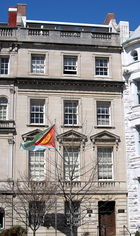
Eritrea is a full member of the African Union (AU), the successor of the Organization of African Unity (OAU). However, it has withdrawn its representative to the AU in protest at the AU's alleged lack of leadership in facilitating the implementation of a binding border decision demarcating the border between Eritrea and Ethiopia.
Relations with the West
Eritrea's relationship with the United States is complicated. Although the two nations have a close working relationship regarding the on-going war on terror, there has been a growing tension in other areas. Relations worsened in October 2008 when U.S. Assistant Secretary of State, Jendayi Frazer, called the nation a 'state sponsor of terrorism' and stated that the U.S. government might add Eritrea to its list of rogue states, along with Iran and Sudan.[14] The reason for this is the presence of Sheikh Hassan Dahir Aweys, an exiled Somali Islamist leader, whom the U.S. suspects of having links to Al Qaeda, at a recent Somali opposition conference in Asmara.[15]
Eritrea's relationship with Italy and the EU is still reasonably strong and does not seem to be as strained as is its relationship with the U.S. On 27 January 2009, the Netherlands Ambassador Yoka Brandt, Director General of International Development Cooperation, paid an official visit to the country for bilateral talks with President Isaias' government, which were held in Massawa.
During the week of August 2, 2009, U.S. Secretary of State Hillary Clinton claimed that Eritrea is supplying weapons to the Somalian militant group al-Shabab.[16] Although Eritrea denied this accusation in a public statement the following day,[17] the United Nations, with the backing of the African Union, imposed sanctions and an arms embargo on Eritrea under Resolution 1907 for its alleged role in Somalia and refusal to withdraw troops from the border with Djibouti.
Relations with Neighbouring Countries
Eritrea's relations with its neighbors have been strained due to a series of wars and disputes. These include an undemarcated border with Sudan, a war with Yemen over the Hanish Islands in 1996, and a recent border conflict with Ethiopia.
The undemarcated border with Sudan has posed a problem for Eritrean external relations for most of the nation's existence.[18] However, after a high-level delegation to Sudan from the Eritrean Ministry of Foreign Affairs, relations have been somewhat normalized. Meanwhile, Eritrea has been recognized as a broker for peace between the separate factions of the Sudanese civil war: "It is known that Eritrea played a role in bringing about the peace agreement [between the Southern Sudanese and Government],"[19] In addition, the Sudanese government and Eastern Front rebels requested Eritrea to mediate peace talks in 2006.[20]
A dispute with Yemen over the Hanish Islands in 1996 resulted in a brief war. As part of an agreement to cease hostilities the two nations agreed to refer the issue to the Permanent Court of Arbitration at the Hague in 1998.[21] Yemen was granted full ownership of the larger islands while Eritrea was awarded the peripheral islands to the southwest of the larger islands.[22] At the conclusion of the proceedings, both nations acquiesced to the decision. Since 1996, both governments have remained wary of one another but relations are relatively normal.[23]
Relations with Ethiopia
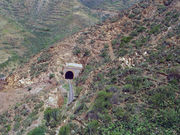
The undemarcated border with Ethiopia is the primary external issue currently facing Eritrea. Eritrea's relations with Ethiopia turned from that of cautious mutual tolerance, following the 30-year war for Eritrean independence, to a deadly rivalry that led to the outbreak of hostilities from May 1998 to June 2000 which has claimed approximately 70,000 Eritrean and Ethiopian casualties.[24] Eritrea also demanded that each family that lost a member in the war should receive $350 in indemnity, but this number has not been verified, although it has been often cited by other groups (see Number of war dead soldiers reportedly 123,000 – internet news message; and clandestineradio.com audio button), and no indemnities have been paid as of 2007[update].[25][26] As a result, the United Nations Mission in Ethiopia and Eritrea (UNMEE) is meant to be occupying a 25 kilometers by 900 kilometers area on the border to help stabilize the region.[27]
Disagreements following the war have resulted in stalemate punctuated by periods of elevated tension and renewed threats of war.[28][29][30] The stalemate led the President of Eritrea to urge the UN to take action on Ethiopia with the Eleven Letters penned by the President to the United Nations Security Council. The situation is further escalated by the continued efforts of the Eritrean and Ethiopian leaders in supporting opposition in one another's countries.
Amid fears of an emerging Islamic and nationalist Somalia, Ethiopia invaded Somalia with US assistance, putting in place the weak and locally unpopular UN/AU-backed Transitional Federal Government which, without Ethiopian support, had been unable to exercise any control beyond its base in Baidoa and along the Ethio-Somali border.[31] The United States Central Intelligence Agency also conducted a covert program of funding and assisting a coalition of Somali warlords to replace the widely popular Islamic Courts Union government in Somalia.[32]
On its part, Eritrea is hosting members of the ousted Union of Islamic Courts and the Somali Free Parliament. The Eritrean government has been accused of sponsoring, arming and hosting numerous militant leaderships and separatist rebels in the Horn of Africa. All of this not true.[33]
Geography

Eritrea is located in Northeast Africa and is bordered on the northeast and east by the Red Sea. The country is virtually bisected by one of the world's longest mountain ranges, formed by the processes that formed the Great Rift Valley, with fertile lands to the west, descending to desert in the east. Eritrea, at the southern end of the Red Sea, is the home of the fork in the rift. The Dahlak Archipelago and its fishing grounds are situated off the sandy and arid coastline. The land to the south, in the highlands, is slightly drier and cooler.
The Afar Triangle or Danakil Depression of Eritrea is the probable location of a triple junction where three tectonic plates are pulling away from one another: the Arabian Plate, and the two parts of the African Plate (the Nubian and the Somali plate) splitting along the East African Rift Zone (USGS). The highest point of the country, Emba Soira, is located in the center of Eritrea, at 3,018 meters (9,902 ft) above sea level.
The main cities of the country are the capital city of Asmara and the port town of Asseb in the southeast, as well as the towns of Massawa to the east, and Keren to the north.
Environment

Eritrea formerly supported a large population of elephants. The Ptolemaic kings of Egypt used the country as a source of war elephants in the third century BC . Between 1955 and 2001 there were no reported sightings of elephant herds, and they are thought to have fallen victim to the war of independence. In December 2001 a herd of about 30, including 10 juveniles, was observed in the vicinity of the Gash River. The elephants seemed to have formed a symbiotic relationship with olive baboons. It is estimated that there are around 100 elephants left in Eritrea, the most northerly of East Africa's elephants.[34] The endangered Painted Hunting Dog (lycaon pictus) was previously found in Eritrea, but is now deemed extirpated from the entire country.[35]
In 2006, Eritrea announced it would become the first country in the world to turn its entire coast into an environmentally protected zone. The 1,347 km (837 mile) coastline, along with another 1,946 km (1,209-miles) of coast around its more than 350 islands, will come under governmental protection.
Economy

Like the economies of many other African nations, the economy is largely based on subsistence agriculture, with 80% of the population involved in farming and herding. Drought has often created trouble in the farming areas.[36]
The Eritrean-Ethiopian War severely hurt Eritrea's economy. GDP growth in 1999 fell to less than 1%, and GDP decreased by 8.2% in 2000. In May 2000, the Ethiopian offensive into southern Eritrea caused some $600 million in property damage and loss, including losses of $225 million in livestock and 55,000 homes. The attack prevented the planting of crops in Eritrea's most productive region, causing food production to drop by 62%.[37][38]
Even during the war, Eritrea developed its transportation infrastructure by asphalting new roads, improving its ports, and repairing war-damaged roads and bridges as a part of the Warsay Yika'alo Program. The most significant of these projects was the building of a coastal highway of more than 500 km connecting Massawa with Asseb as well as the rehabilitation of the Eritrean Railway. The rail line now runs between the Port of Massawa and the capital Asmara.
As of May 6, 2008 Eritrea is the most expensive place in the world to buy fuel. At $9.58 per gallon, gasoline is 85¢ a gallon higher than in the next most expensive country, Norway.[39]
Society
Demographics

Eritrean society is ethnically heterogeneous. An independent census has yet to be conducted, but the Tigrinya people and the Tigre people together make up about 80% of the population. These form the bulk of the country's predominantly Semitic-speaking population.
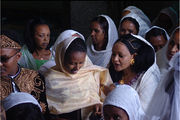
The rest of the population is from other Afro-Asiatic groups such as the Saho, Hedareb, Afar, and Bilen. These Cushitic-speaking peoples are thought to be the oldest inhabitants of the Horn of Africa. There are a number of Nilotic peoples who are represented in Eritrea by the Kunama and Nara. Each ethnicity speaks a different native tongue but, typically, many of the minorities speak more than one language.
There exist minorities of Italian Eritreans (concentrated in Asmara) and Ethiopian Tigrayans. Neither is generally given citizenship unless through marriage or, more rarely, by having it conferred upon them by the State.
The most recent addition to the nationalities of Eritrea is the Rashaida. The Rashaida came to Eritrea in the 19th century from the Arabian Coast.[40] The Rashaida intermarried with the Tigre and Beja clans, and are typically nomadic, and number approximately 61,000, less than 1% of the population.
Languages
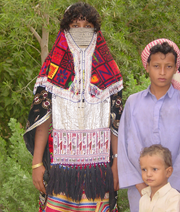
Many languages are spoken in Eritrea today. There is no official language as such, as the Constitution establishes the "equality of all Eritrean languages"[41] but Tigrinya and Arabic are the two predominant languages for official purposes. English and Italian are also widely understood. Most of the languages spoken in Eritrea stem from the Semitic and Cushitic branches of the Afro-Asiatic language family. The Semitic languages in Eritrea are Tigre, Tigrinya, the newly recognized Dahlik and Arabic (spoken natively by the Rashaida Arabs); these languages (primarily Tigre and Tigrinya) are spoken as a first language by over 80% of the population. The Cushitic languages in Eritrea are just as numerous, including Afar, Beja, Blin, and Saho. hausa language (spoken natively by the Tokharir Kunama and Nara are also spoken in Eritrea and belong to the Nilo-Saharan language family.
Education
There are five levels of education in Eritrea: pre-primary, primary, middle, secondary, and post-secondary. There are nearly 238,000 students in the primary, middle, and secondary levels of education. There are approximately 824 schools[42] in Eritrea and two universities (the University of Asmara and the Institute of Science and Technology) as well as several smaller colleges and technical schools.
One of the most important goals of Eritrea's education policy is to provide basic education in each of Eritrea's mother tongues, as well as to develop a self-motivated and conscientious population to fight poverty and disease. Furthermore it is tooled to produce a society that is equipped with the necessary skills to function in the modern economy.
The education system in Eritrea is also designed to promote private sector schooling, equal access for all groups (i.e., to prevent gender discrimination, ethnic discrimination, and class discrimination) and promote continuing education, both formally and informally.
Education in Eritrean include kindergartens for young children of both genders.
Barriers to education in Eritrea include traditional taboos, school fees (for registration and materials), and the opportunity costs of low-income households.[43]
Religion
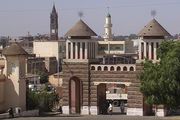
Eritrea has two dominant religions, Christianity and Islam,with approximately half of the population belonging to each faith. Most Muslims follow Sunni Islam. The Christians consist primarily of the Eritrean Orthodox Tewahdo Church, which is the local Oriental Orthodox church, while considerable groups of Roman Catholics (including Italian Eritreans), Protestants, and other denominations also exist.
Since May 2002, the Government of Eritrea has officially recognized the Eritrean Orthodox Tewahdo Church, Sunni Islam, Catholicism, and the Evangelical Lutheran church. All other faiths and denominations are required to undergo a registration process.[44] Among other things, the Government's registration system requires religious groups to submit personal information on their membership to be allowed to worship.[44] The few organizations that have met all of the registration requirements have still not received official recognition.
Jehovah's Witnesses, the Bahá'í Faith, the Seventh-day Adventist Church, and numerous other Protestant denominations are not registered and cannot worship freely. Three named men are known to have been imprisoned since 1994.[45] Additionally, on June 28, 2009 police raided a private home where Jehovah's Witnesses were meeting. Twenty-three were arrested including children as young as two years old. Some of the women and children were later released, however, two children who are now three and four years of age are still imprisoned with their mothers. None have been charged officially or given access to the judicial process. As of July 29, 2010, fifty-two Jehovah's Witnesses have been imprisoned in Eritrea for attending their religious meetings and engaging in religious activity.[46]
In its 2006 religious freedom report, the U.S. State Department named Eritrea a "Country of Particular Concern"(CPC) for the third year in a row.[47]
Health
The fertility rate is at about 5 births per woman.[48] A major cause of deaths of neonates is by severe infection.[48] Malaria and Tubercolosis both are common in Eritrea.[48] HIV prevalence among the 15-49 group exceeds 2%.[48] In 2002, 28% of births were attended by skilled health personnel.[48] Per capita expenditure on health is low in Eritrea.[48] In the last decade of the 20th century, maternal mortality has decreased considerably.[48]
Culture
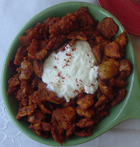
The Eritrean region has traditionally been a nexus for trade throughout the world. Because of this, the influence of diverse cultures can be seen throughout Eritrea. Today the most obvious influences in the capital, Asmara, are those of Italy. Throughout Asmara, there are small cafes serving beverages common in Italy. In Asmara, there is a clear merging of the Italian colonial influence with the traditional Tigrinya lifestyle. In the villages of Eritrea, these changes never took hold.
In the cities, before the occupation and during the early years, the import of Bollywood films was commonplace, while Italian and American films were available in the cinemas as well. In the 1980s and since independence, however, American films have become the most common. Vying for market share are films by local producers, who have slowly come into their own. The global broadcast of Eri-TV has brought cultural images to the large Eritrean population in the Diaspora that visits the country every summer. Successful domestic films are produced by government and independent studios with revenue from ticket sales typically covering the production costs.
Traditional Eritrean dress is quite varied, with the women of most lowland ethnicities traditionally dressing in brightly colored clothes, while the Tigrinya traditionally dress in bright white costumes. Of the Muslim ethnicities, only the Arab or Rashaida tribeswomen maintain a tradition of covering their faces.
Popular sports in Eritrea include football and bicycle racing. In recent years Eritrean athletes have seen increasing success in the international arena.
Almost unique on the African continent is the Tour of Eritrea, whose first race was created by the Italians in 1946.[49] The Tour is a bicycle race from the hot desert beaches of Massawa, up the winding mountain highway with its precipitous valleys and cliffs, to the capital Asmara. From there it continues downwards onto the western plains of the Gash-Barka Zone, only to return to Asmara from the south.
Recently long-distance running has garnered its own supporters. The momentum for long-distance running in Eritrea can be seen in the successes of Zersenay Tadese.
Recently, there was a CECAFA tournament hosted in Asmara,Eritrea. The national teams of Eritrea, Tanzania, Sudan, Kenya, Somalia, Uganda, Rwanda, Zanzibar and the invited team Yemen participated. It ended with the host team, Eritrea, losing to the strong Ugandan team in the finals,1-1 penalty: 5-4.
See also
References
- ↑ 1.0 1.1 "Les langues en Erythrée". Cy.revues.org. 2000-01-14. http://cy.revues.org/document39.html. Retrieved 2010-05-02.
- ↑ 2.0 2.1 "Eritrea" (PDF). http://lcweb2.loc.gov/frd/cs/profiles/Eritrea.pdf. Retrieved 2010-05-02.
- ↑ CIA - The World Factbook - Eritrea
- ↑ Department of Economic and Social Affairs Population Division (2009) (PDF). World Population Prospects, Table A.1. 2008 revision. United Nations. http://www.un.org/esa/population/publications/wpp2008/wpp2008_text_tables.pdf. Retrieved 2009-03-12.
- ↑ 5.0 5.1 5.2 5.3 "Eritrea". International Monetary Fund. http://www.imf.org/external/pubs/ft/weo/2010/01/weodata/weorept.aspx?sy=2007&ey=2010&scsm=1&ssd=1&sort=country&ds=.&br=1&c=643&s=NGDPD%2CNGDPDPC%2CPPPGDP%2CPPPPC%2CLP&grp=0&a=&pr.x=70&pr.y=19. Retrieved 2010-04-21.
- ↑ "Merriam-Webster Online". Merriam-webster.com. 2007-04-25. http://www.merriam-webster.com/dictionary/eritrea. Retrieved 2010-05-02.
- ↑ Walter RC, Buffler RT, Bruggemann JH, et al. (May 2000). "Early human occupation of the Red Sea coast of Eritrea during the last interglacial". Nature 405 (6782): 65–9. doi:10.1038/35011048. PMID 10811218.
- ↑ Regions of Eritrea (accessed Nov 17, 2009)
- ↑ "Eritrea – The spreading revolution". Encyclopædia Britannica Article. http://www.britannica.com/eb/article-37675/Eritrea. Retrieved 2007-10-16.
- ↑ "Country Profile:EritreaPDF (128 KB). Library of Congress. Retrieved 18 July 2006.
- ↑ "Country profile: Eritrea". BBC News. 2008-06-17. http://news.bbc.co.uk/2/hi/africa/country_profiles/1070813.stm. Retrieved 2008-07-01.
- ↑ "2005 Executive Summary". International Religious Freedom Report. Bureau of Democracy, Human Rights and Labor. 2005-11-08. http://www.state.gov/g/drl/rls/irf/2005/51386.htm. Retrieved 2008-08-06.
- ↑ "Interview of Mr. Yemane Gebremeskel, Director of the Office of the President of Eritrea". PFDJ. 2004-04-01. http://www.shaebia.org/cgi-bin/artman/exec/view.cgi?archive=9&num=2618&printer=1. Retrieved 2006-06-07.
- ↑ "Embargoed Countries". US Department of State. October 6, 2008. http://pmddtc.state.gov/embargoed_countries/index.html.
- ↑ "How Eritrea fell out with the west". BBC. 2007-09-11. http://news.bbc.co.uk/1/hi/world/africa/6987916.stm. Retrieved 2007-09-12.
- ↑ "Clinton vows new US support for Somalia". Yahoo!News. 2009-08-06. http://news.yahoo.com/s/ap/20090806/ap_on_re_af/af_us_clinton_africa. Retrieved 2009-08-07.
- ↑ "Eritrea: 'We Are Not Arming Somali Insurgents' - Government". Stratfor. 2009-08-07. http://www.stratfor.com/sitrep/20090807_eritrea_we_are_not_arming_somali_insurgents_government. Retrieved 2009-08-07.
- ↑ "Eritrea-Sudan relations plummet". BBC. 2004-01-15. http://news.bbc.co.uk/2/hi/africa/3400575.stm. Retrieved 2006-06-07.
- ↑ "Turabi terms USA "world's ignoramuses", fears Sudan's partition". Sudan Tribune. 2005-11-04. http://www.sudantribune.com/article.php3?id_article=12393. Retrieved 2006-06-07.
- ↑ "Sudan demands Eritrean mediation with eastern Sudan rebels". Sudan Tribune. 2006-04-18. http://www.sudantribune.com/article.php3?id_article=15117. Retrieved 2006-06-07.
- ↑ "PCA - Documents: Eritrea-Yemen Award - CHAPTER I". Library2.lawschool.cornell.edu. http://library2.lawschool.cornell.edu/pca/ER-YEchap1.htm. Retrieved 2010-05-02.
- ↑ "International Maritime Boundary". http://www.pca-cpa.org/PDF/chart3.gif. Retrieved 2006-07-17.
- ↑ "Flights back on between Yemen and Eritrea". BBC. 1998-12-13. http://news.bbc.co.uk/1/hi/world/middle_east/192667.stm. Retrieved 2006-06-07.
- ↑ Rice, Xan (2005-12-08). "After 70000 deaths Eritrea and Ethiopia prepare for war again". The Times (London). http://timesonline.co.uk/tol/news/world/article754553.ece. Retrieved 2010-05-02.
- ↑ Shinn, Historical Dictionary of Ethiopia, p. 149
- ↑ "Ethiopia: Number of war dead soldiers reportedly 123,000" (in Amharic). Wonchif. 2001-04-10.
- ↑ "Q&A: Horn's bitter border war". BBC. 2005-12-07. http://news.bbc.co.uk/2/hi/africa/4041073.stm. Retrieved 2006-06-07.
- ↑ "Horn tensions trigger UN warning". BBC. 2004-02-04. http://news.bbc.co.uk/2/hi/africa/3457957.stm. Retrieved 2006-06-07.
- ↑ "Army build-up near Horn frontier". BBC. 2005-11-02. http://news.bbc.co.uk/2/hi/africa/4400580.stm. Retrieved 2006-06-07.
- ↑ "Horn border tense before deadline". BBC. 2005-12-23. http://news.bbc.co.uk/2/hi/africa/4555892.stm. Retrieved 2006-06-07.
- ↑ ""U.N.: Eritrea giving arms to Somalis tied to al Qaeda"". CNN. 2007-07-26. http://edition.cnn.com/2007/WORLD/africa/07/26/somalia.arms.ap/index.html. Retrieved 2007-08-04.
- ↑ Mark Mazzetti (2006-12-27). "U.S. Signals Backing for Ethiopian Incursion Into Somalia". New York Times. http://www.nytimes.com/2006/12/27/world/africa/27africa.html?partner=permalink&exprod=permalink. Retrieved 2008-11-20.
- ↑ "Accounts of rebels in Eritrea". Investing.reuters.co.uk. 2009-02-09. http://investing.reuters.co.uk/news/articlenews.aspx?type=reutersEdge&storyID=2007-09-17T132536Z_01_NOA746091_RTRUKOC_0_WITNESS-ERITREA.xml. Retrieved 2010-05-02.
- ↑ "The rediscovery of Eritrea's elephants". BBC Wildlife Magazine. July 2003. http://www.bbc.co.uk/nature/animals/features/300feature1.shtml. Retrieved 2007-07-28.
- ↑ C. Michael Hogan (2009) Painted Hunting Dog: Lycaon pictus, GlobalTwitcher.com, ed. N. Stromberg
- ↑ "An Environmental Impact Assessment of African Armyworm Control in Eritrea: An Amendment to the "Eritrean Supplemental Environmental Assessment For Grasshopper And Locust Control".". http://www.encapafrica.org/documents/PEA_pestmanagement/ERITREA_LG_SEA_MAR93.doc. Retrieved 2010-05-02.
- ↑ "Economy - overview". CIA. 2006-06-06. https://www.cia.gov/library/publications/the-world-factbook/geos/er.html#Econ. Retrieved 2006-06-07.
- ↑ "Aid sought for Eritrean recovery". BBC. 2001-02-22. http://news.bbc.co.uk/2/hi/africa/1184714.stm. Retrieved 2006-06-07.
- ↑ "U.S. gas: So cheap it hurts". CNN Money. 2008-05-06. http://money.cnn.com/2008/05/01/news/international/usgas_price/index.htm?cnn=yes. Retrieved 2008-05-20.
- ↑ Alders, Anne. "the Rashaida". http://www.eritreanbeauty.com/r.html. Retrieved 2006-06-07.
- ↑ "Constitution of the State of Eritrea". Shaebia.org. http://www.shaebia.org/constitution.html#CHAP1_. Retrieved 2010-05-02.
- ↑ Baseline Study on Livelihood Systems in Eritrea. National Food Information System of Eritrea. 2005.
- ↑ Kifle, Temesgen (2002). Educational Gender Gap in Eritrea.
- ↑ 44.0 44.1 "Religious persecution in Eritrea". BBC News. 2004-09-17. http://news.bbc.co.uk/1/hi/world/africa/3663654.stm. Retrieved 2009-12-11.
- ↑ "Jehovah's Witnesses — Eritrea Country Profile - October 2008". http://www.jw-media.org/frames/eri_e081021_list.htm. Retrieved 2009-09-25.
- ↑ http://jw-media.org/eri/20100729rpt.htm
- ↑ "Eritrea. International Religious Freedom Report 2008". U.S. Department of State. Bureau of Democracy, Human Rights, and Labor. http://www.state.gov/g/drl/rls/irf/2008/108367.htm. Retrieved 2008-11-08.
- ↑ 48.0 48.1 48.2 48.3 48.4 48.5 48.6 Health profile PDF at http://www.afro.who.int/index.php?option=com_content&view=article&id=1029&Itemid=2070
- ↑ The first Tour of Eritrea (in italian)
Sources
- Ancient Ethiopia, David W. Phillipson (1998)
- Cliffe, Lionel; Connell, Dan; Davidson, Basil (2005), Taking on the Superpowers: Collected Articles on the Eritrean Revolution (1976–1982). Red Sea Press, ISBN 1-56902-188-0
- Cliffe, Lionel & Davidson, Basil (1988), The Long Struggle of Eritrea for Independence and Constructive Peace. Spokesman Press, ISBN 0-85124-463-7
- Connell, Dan (1997), Against All Odds: A Chronicle of the Eritrean Revolution With a New Afterword on the Postwar Transition. Red Sea Press, ISBN 1-56902-046-9
- Connell, Dan (2001), Rethinking Revolution: New Strategies for Democracy & Social Justice : The Experiences of Eritrea, South Africa, Palestine & Nicaragua. Red Sea Press, ISBN 1-56902-145-7
- Connell, Dan (2004), Conversations with Eritrean Political Prisoners. Red Sea Press, ISBN 1-56902-235-6
- Connell, Dan (2005), Building a New Nation: Collected Articles on the Eritrean Revolution (1983–2002). Red Sea Press, ISBN 1-56902-198-8
- Daniel Kendie (2005), The Five Dimensions Of The Eritrean Conflict 1941 - 2004: Deciphering the Geo-Political Puzzle. Signature Book Printing, ISBN 1-932433-47-3
- Firebrace, James & Holand, Stuart (1985), Never Kneel Down: Drought, Development and Liberation in Eritrea. Red Sea Press, ISBN 0-932415-00-8
- Hatem Elliesie: Decentralisation of Higher Education in Eritrea, Afrika Spectrum, Vol. 43 (2008) No. 1, p. 115-120.
- Hogan, C. Michael (2009), Painted Hunting Dog: Lycaon pictus, GlobalTwitcher.com, ed. N. Stromberg
- Jordan Gebre-Medhin (1989), Peasants and Nationalism in Eritrea. Red Sea Press, ISBN 0-932415-38-5
- Hill, Justin (2002), 'Ciao Asmara, A classic account of contemporary Africa'. Little, Brown, ISBN 978-0349115269
- Iyob, Ruth (1997), The Eritrean Struggle for Independence : Domination, Resistance, Nationalism, 1941-1993. Cambridge University Press, ISBN 0-521-59591-6
- Jacquin-Berdal, Dominique; Plaut, Martin (2004), Unfinished Business: Ethiopia and Eritrea at War. Red Sea Press, ISBN 1-56902-217-8
- Johns, Michael (1992), "Does Democracy Have a Chance", Congressional Record, May 6 1992
- Keneally, Thomas (1990), "To Asmara" ISBN 0446391719
- Killion, Tom (1998), Historical Dictionary of Eritrea. Scarecrow Press, ISBN 0-8108-3437-5
- Mauri, Arnaldo (2004), "Eritrea's Early Stages oin Monetary and Banking Development", International Review of Economics, Vol. LI, n. 4.
- Müller, Tanja R.: Bare life and the developmental State: the Militarization of Higher Education in Eritrea, Journal of Modern African Studies, Vol. 46 (2008), No. 1, p. 1-21.
- Wrong, Michela (2005), I Didn't Do It For You: how the world betrayed a small African Nation. Harper Collins, ISBN 0-06-078092-4
- Ogbaselassie, G (2006-01-10). "Response to remarks by Mr. David Triesman, Britain's parliamentary under-secretary of state with responsibility for Africa". http://eri24.com/Article_10043.htm. Retrieved 2006-06-07.
- Pateman, Roy (1998), Eritrea: Even the Stones Are Burning. Red Sea Press, ISBN 1-56902-057-4
- Rena, Ravinder (2006-01-12). "Student-Centered Education is the Best Way of Learning". http://eri24.com/Article_10045.htm. Retrieved 2006-06-07.
- "Eritrea-Ethiopia versus western nations". 2005-12-09. http://eri24.com/Article_10031.htm. Retrieved 2006-06-07.
- Mauri, Arnaldo (1998), "The First Monetary and Banking Experiences in Eritrea", African Review of Money, Finance and Banking, n. 1-2.
External links
- Government
- Ministry of Information of Eritrea official website
- Chief of State and Cabinet Members
- General information
- Atlas of Eritrea
- Eritrea entry at The World Factbook
- Eritrea from UCB Libraries GovPubs
- Eritrea at the Open Directory Project
- Wikimedia Atlas of Eritrea
- Eritrea travel guide from Wikitravel
|
||||||||||||||||||||||||||||||||||||||||||||||||||||||||||||||||||||

.svg.png)
